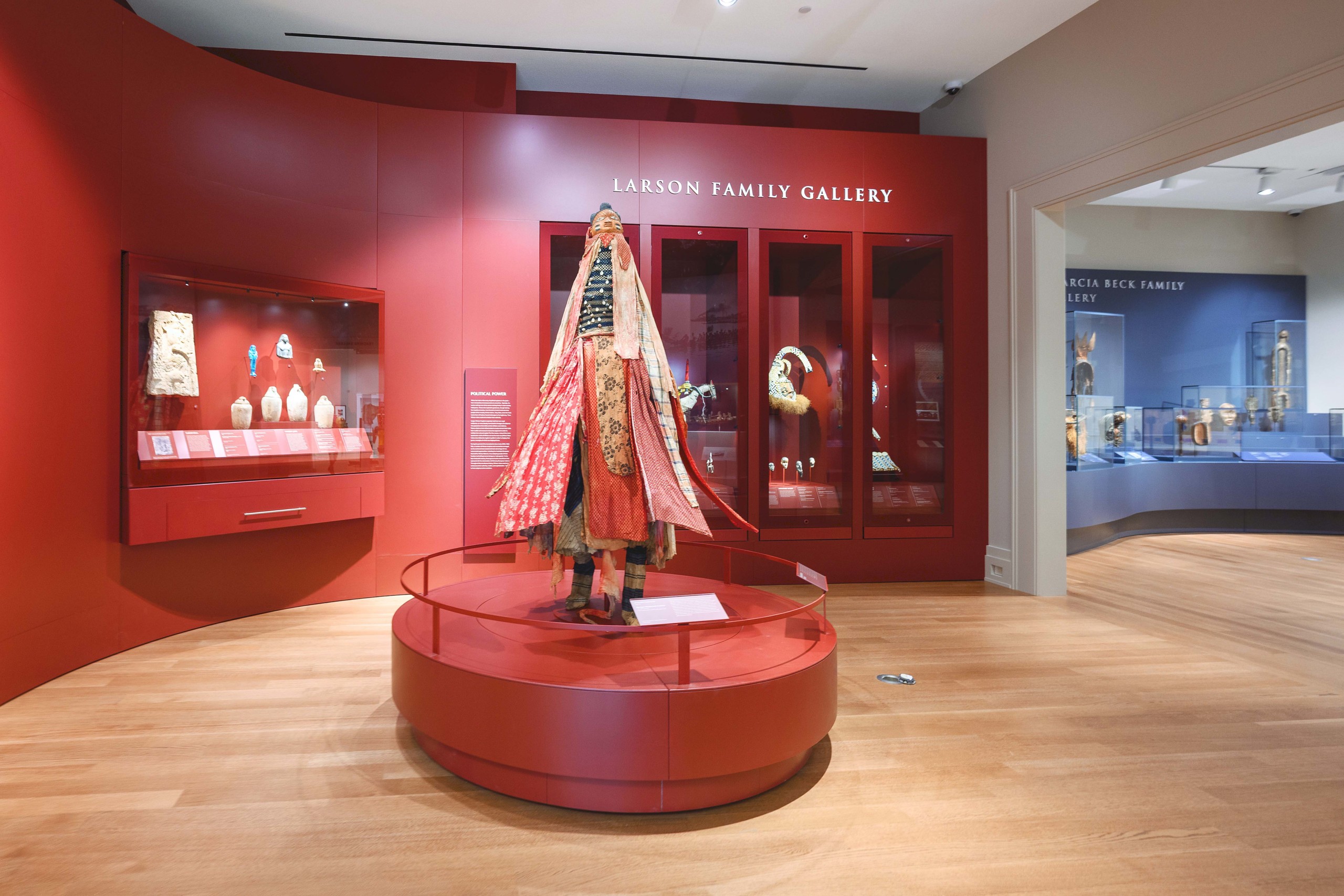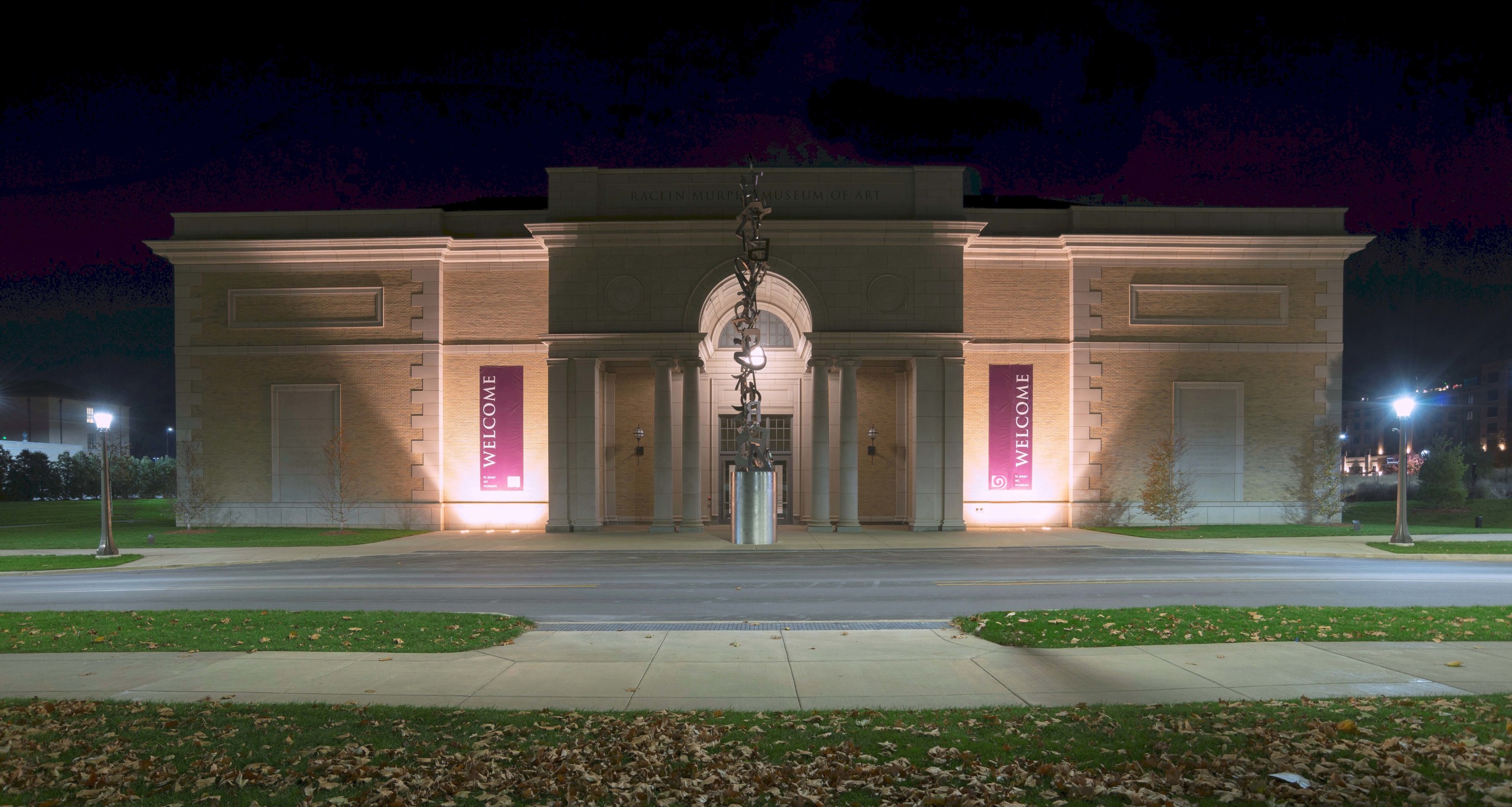
Exterior of Raclin Murphy Museum of Art. Jaume Plensa (Spanish, b 1955), “Endless,” 2023. Courtesy of Raclin Murphy Museum of Art.
By W.A. Demers, Senior Editor
SOUTH BEND, IND. — Bright and shiny, they open their doors to old friends and new generations of art lovers, students and scholars. These are the nation’s new museums, boasting state-of-the-art galleries, reengineered HVAC systems promising 24/7 climate optimization for both patrons and artworks, exteriors that beckon and amenities that rival those enjoyed in shopping malls. In April of 2023, we saw the opening of the New Bruce in Greenwich, Conn., a gleaming edifice with cast stone and glass exterior forming the extensive new shell housing an additional 44,000-square-feeet to showcase its growing art and science collections.
In New York City, the Frick Collection undertook a renovation and enhancement project to better serve a Twenty-First Century audience. Now we see the opening of a new museum at the University of Notre Dame, unveiling site-specific installations, state-of-the-art galleries and spaces for learning and connection. Since it opened its doors on December 1 with three days of opening events drawing more than 5,000 visitors, those visitors have been coming from across the United States and the wider world to what was formerly the Snite Museum of Art, now the new Raclin Murphy Museum of Art. Multiple events on December 1, 2 and 3 included programs for different age groups and interests.
Critics can speculate on why smaller, regional institutions are playing catch-up with their larger, well-endowed peers, but each is a special case with unique reasons for expanding the homes of their collections. In the Raclin Murphy’s case, it was the desire to showcase newly commissioned works by globally renowned artists in a way that would integrate them into the fabric of the building design. “The permanent collection, which will celebrate its sesquicentennial in 2025, has been reinstalled with new life and vigor, giving visitors the opportunity to reconnect with and experience cherished artworks from a new perspective,” said Joseph Antenucci Becherer, director of the Raclin Murphy Museum of Art.

Gallery installation view of Raclin Murphy Museum of Art. Courtesy of Raclin Murphy Museum of Art.
He told Antiques and The Arts Weekly, “It’s been an extraordinary journey but in the same breath it’s also just a beginning.” Once you build it, they will come, the saying goes, but you have to have something to show them when they come.” [The opening] was full of joy, full of energy and brought people who had never been to the former museum,” said Becherer. “Even people who don’t necessarily engage with museums on a regular basis. We brought them, we welcomed them and we hope they come back many times.”
The new 70,000-square-foot building is designed by the award-winning Robert A.M. Stern Architects (RAMSA), a firm that has plenty of credibility in the field of classically inspired architecture. In designing an expanded home for the university’s art collections in a way that combined both tradition and innovation, RAMSA ensured that the building’s brick, cast stone and Indiana limestone exterior was compatible with the campus’ other historic buildings. The idea was to establish the new museum as a gateway to an evolving on-campus arts district.
That “gateway” is quite literal with a massive, soaring sculpture by Spanish artist Jaume Plensa (b 1955), “Endless,” a 36-foot stainless steel sculpture positioned outside of the museum entrance. Featured in the work of art are alphabets in eight different languages that speak to the university’s commitment to “diversity, internationalization, knowledge and global service.”

Exterior of Raclin Murphy Museum of Art. Jaume Plensa (Spanish, b 1955), “Endless,” 2023 (detail). Courtesy of Raclin Murphy Museum of Art.
“I have known and worked with Jaume for many years,” explained Becherer. “When we knew that we would have a space that would be central to the entrance — and vice versa, back out into the world — he immediately came to mind. The piece is a kind of organic tower composed of the alphabets of eight different languages. They don’t form words but represent languages and cultures and, by extension, people. [Jaume} sees it as a bridge between earth and sky built on knowledge.”
The front façade of the building carries more inspirational text, this by Jenn Holzer, in a panel reading, “We are in the midst of reality responding with joy.”
The museum’s interior with 16-foot-high ceilings comprises 23 historically thematic galleries grouped around a multi-level atrium that rises to a central skylight. Atriums let light flood in and this one is no exception, doing double duty by presenting works from the Raclin Murphy collection as it connects the building’s upper and lower floors, accessed by two sweeping staircases.

Raclin Murphy Museum of Art central skylight. Courtesy of Raclin Murphy Museum of Art.
“The permanent collection, which will celebrate its sesquicentennial in 2025, has been reinstalled with new life and vigor, giving visitors the opportunity to reconnect with and experience cherished artworks from a new perspective,” said Becherer. There are education spaces, a teaching gallery, an object study center and a chapel. The galleries are state-of-the-art, spacious canvases for works from the university’s art collection, which tallies more than 30,000 objects. The collections date to 1875, having grown into one of the most significant and extensive collections of any academic museum in the United States, a showcase offering glimpses of world art history in paintings, sculptures, ceramics, prints, drawings, textiles, baskets and decorative arts.
A circular terrazzo and bronze floor installation by Kiki Smith, “Sea of Stars,” greets visitors stepping into the atrium. It features 39 hand-drawn and cast stars inspired by celestial images frequently seen in medieval, Renaissance and Byzantine depictions of the Madonna as protectress and “Star of the Sea.”
The museum’s chapel is dominated by Mimmo Paladino’s “Mary, Queen of Families,” a large-scale commission complementing the medieval and Renaissance altarpieces in this sacred space and offering yet another bridge spanning art history and the history of the Catholic Church.

Mimmo Paladino (Italian, b 1948), “Mary, Queen of Families,” 2023 (detail of ceiling). Courtesy of Raclin Murphy Museum of Art.
“My hope for the new museum is two-fold,” shared Becherer. “On one hand, that we continue to be a really important and significant resource for the academy both at Notre Dame and for scholars all over the world — because we are an academic art museum. On the other side, I really hope that we become a kind of national attraction that people coming into this part of the Midwest will feel interested in spending some time with us. The collections are quite extraordinary, and the menu of things we’re working on, including exhibition programming, are quite extraordinary.”
Recent acquisitions and newly commissioned art add to the museum’s holdings of global works and complement objects from the permanent collection, many of which underwent conservation or professional cleaning before being moved to the new building. “There were a lot of things that we decided, quite judiciously, to conserve,” said Becherer. “And, of course, we made some very nice new acquisitions.” These include works by Magdalena Abakanowicz, Zhang Huan, Dietrich Klinge, Julie Mehretu, David Ocelotl Garcia, Jamie Okuma, Yinka Shonibare, Ursula von Rydingsvard, Dana Warrington, Jason Wesaw and others.
When the director speaks of the new museum as a journey and a new beginning, he’s referring to the Raclin Murphy’s second phase, a 62,000-square-foot facility dedicated to research with additional galleries and space for teaching, a works-on-paper study center, administrative and curatorial offices, open collections storage and an auditorium. The timeline for that construction is to be determined.

Gallery installation view of Raclin Murphy Museum of Art. Courtesy of Raclin Murphy Museum of Art.
“Along with my dedicated colleagues, we say welcome to what is and what can be. Nurturing an ongoing culture of learning through art, we’ve realized this new space to bring the campus and national community together. We have built a building and filled its spaces, but only together can we give the Raclin Murphy Museum of Art the soul it merits,” said Becherer.
The late Ernestine Raclin and her daughter and son-in-law Carmen and Chris Murphy are the lead benefactors of the Raclin Murphy Museum of Art. Admission to the Raclin Murphy Museum of Art is free.
The Raclin Murphy Museum of Art is at St André Way (corner of Eddy Street and Angela Boulevard), University of Notre Dame. For more information, www.raclinmurphymuseum.nd.edu or 574-631-5466.

















